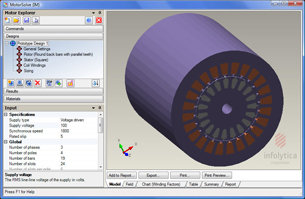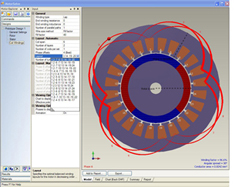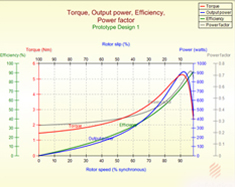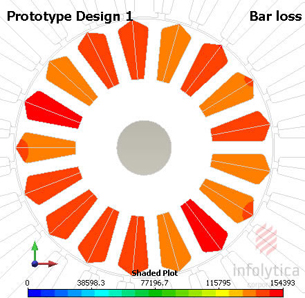June 17, 2009
By DE Editors
 An example of the MotorSolve interface. |
Infolytica Corp. (Montreal, QUE) has announced the availability of MotorSolve v2.2, an upgrade to the company’s software for designing rotating electric machines, including induction machines, switched reluctance machines, and brushless DC motors and generators. New features include simulations and performance results for induction machines, more system modeling tools, and additional templates for induction and brushless machines.
MotorSolve v2.2’s IM (induction machine) design and analysis software for induction motors and generators has been upgraded with a new automated FEA (finite element analysis) results module. “We refer to MotorSolve as an automated FEA design tool,” explains Infolytica’s Chad Ghalamzan in a press statement, “since the user doesn’t have to worry about the mesh or any typical postprocessing tasks associated with FEA software.”
 MotorSolve can generate a set of coil span, phase offsets, and balanced winding layout options. |  A MotorSolve plot of torque, output power and efficiency as a function of rotor speed results. |
MotorSolve IM enables you to design while taking into account a such effects such as leakage inductances, iron losses, stator end effects, and the effects of switching on motor characteristics due to inverter fed phases. It uses a template-based GUI said to simplify design creation by enabling designers to select a rotor and stator type then specify such information as number of poles and slots, stack length; geometric dimensions of the bars, bridges and teeth; lamination, coil, and bar material; skew angles; and the temperature for each component.
 The shaded plot of ohmic losses due to bar currents in the model create with MotorSolve. |
The new MotorSolve IM results module enables designers to predict the performance of an induction machine based on user-selected automated FEA simulations that include analyses for induction motor equivalent circuits, AC fields, and pulse width modulation. The results module also offers analysis methods that give designers control over the speed and accuracy of the simulation, including equivalent circuit analysis of an induction machine based on no load/locked rotor tests as well as motion analysis including saturation at each rotor step. Analysis reporting features and results include charts (torque, power, etc.), field plots (flux, losses, etc.), and waveforms (currents,etc.).
MotorSolve also offers both manual and automatic coil windings capabilities. The automated coil winding feature analyzes the electric motor under design and generates an optimal set of balanced coil windings. The resultant coil windings are said to be usable as-is or they can be used as a launching point for user-specific layouts.
MotorSolve v2.2 now also supports exporting designs to VHDL-AMS. It is available for Windows 2000, XP and Vista. For complete details, visit Infolytica on the web.
Click here for a 2-minute, registration-free video of MotorSolve IM.
Explore the Infolytica gallery to see industry solutions.
Contact Infolytica and arrange a private MotorSolve webinar.
Read why DE’s Editors selected MotorSolve v2.2 as their Pick of the Week.
Subscribe to our FREE magazine, FREE email newsletters or both!
About the Author
DE’s editors contribute news and new product announcements to Digital Engineering.
Press releases may be sent to them via [email protected].






